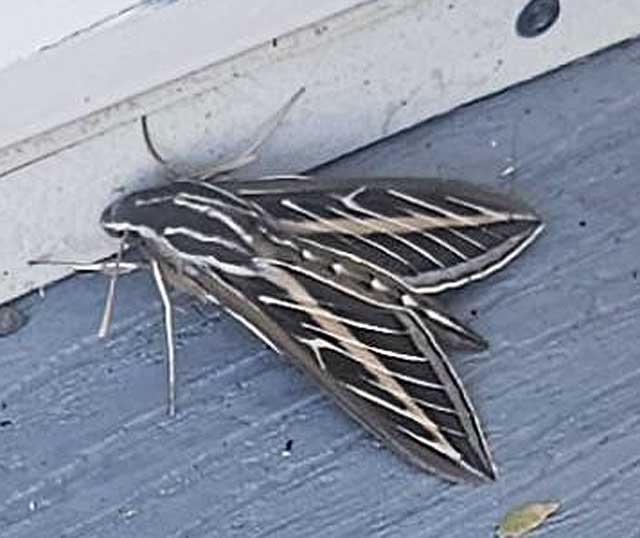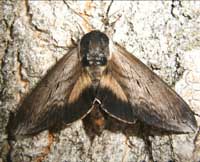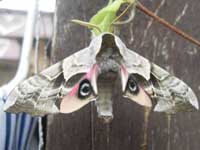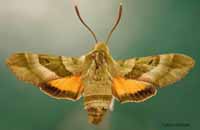Madison County, Idaho
Sphingidae

Hyles lineata nectaring on dandelion
As of June 15, 2021, eighteen Sphingidae species are listed on BAMONA for Idaho. Most of the species are reported or anticipated in Madison County,
but some of those eighteen are decidely more likely to be found in western Idaho and not in eastern parts of the state.. It is hoped that this checklist, with the
thumbnails and notes, will help you quickly identify the moths you have encountered.
A "WO" after the species name indicates that I have no confirmed reports of this species in Madison County, but I
(William Oehlke) expect that this moth is present or might be present.
A BAMONA indicates the moth is reported on the BAMONA website (three species:
One-eyed sphinx (Smerinthus cerisyi), probably Smerinthus ophthalmica;
Bedstraw hawkmoth (Hyles gallii);
White-lined sphinx (Hyles lineata).
Please help me develop this list with improved, documented accuracy by sending sightings (species, date, location), preferably with an
image, via email to Bill Oehlke.

Hyles lineata>, Rexburg, Madison County, Idaho,
September, 2023, courtesy of Susan Dalling.
This page is inspired by and dedicated to Brad and Susan Dalling: Good Friends.
Sphinginae subfamily
Sphingini tribe:
 |
Sphinx drupiferarum
WO,
Wild Cherry Sphinx:
I only see them occasionally on P.E.I. despite visiting lights
frequently. Larvae are large and beautiful. |
 |
Sphinx luscitiosa WO??, Canadian Sphinx, Clemen's Sphinx:
Fw yellowish gray in males; pale gray with faint yellow tint in females.
Dark border on outer margin widens as it approaches inner margin.
Hw deep yellow in males, pale yellow in females; both with wide black border.
|
 |
Sphinx vashti
WO, Snowberry Sphinx:
The upperside of the forewing has a narrow black subterminal line
bordered by a white inverted V-shaped line on the outside, and a
black line running inwards from the apex of the wing.
It is most often found in montane woodlands and along streamcourses. |
Smerinthini Tribe:
 |
Pachysphinx modesta
WO,
the Modest Sphinx or Poplar Sphinx:
This large poplar/willow feeder possibly flies in Ada County.
They are a heavy bodied species.
|
 |
Pachysphinx occidentalis
WO,
the Big Poplar Sphinx:
This one is quite similar to Pachysphinx modesta, with modesta
being smaller and darker.
There may be naturally occuring hybrids in Madison.
|
 |
Paonias excaecata
WO, the Blinded Sphinx:
The grey-blue eyespot of the hindwing gives this species its name.
Larvae feed on birches, willows, cherries and oaks.
The outer edge of the forewings is quite scalloped. |
 |
Paonias myops
WO,
the Small-eyed Sphinx:
This small species is widespread and common and is likely present. This species ranges across North America.
The hindwings have a small blue eyespot ringed with black on a yellow background.
|
 |
Smerinthus opthalmica
MPNw: Larvae feed on poplars, aspen and willows.
Note different shape of double arced forewing pm line compared to the straighter pm line of cerisyi, directly above.
S. ophthalmica has smoother scalloping of the fw outer margin and probably replaces cerisyi in Idaho.
|
Macroglossinae subfamily
Dilophonotini tribe
 |
Hemaris diffinis WO,
the Snowberry Clearwing or Bumblebee Moth:
This day flying moth is widely distributed in Idaho.
I suspect I will get reports from Madison County, however, see note below.. |
Hemaris diffinis is likely replaced in Idaho, and west of Continental Divide by Hemaris thetis.
 |
Hemaris thetis WO, Thetis Clearwing; Bee Hawk Moth:
The moth flies along forest edges and in meadows, gardens and
brushy fields. Day-flying adults nectar at lantana, dwarf bush honeysuckle,
snowberry, orange hawkweed, thistles, lilac, Canada violet, etc.
|
Macroglossini tribe
 |
Hyles gallii
BAMONA,
the Bedstraw Hawk Moth or Gallium Sphinx:
This species is officially reported from Madison County; if
you have Gallium or Epilobium, you probably have
populations of this species. |
 |
Hyles lineata
BAMONA, White-lined Sphinx:
Very widespread. It can be seen flying during the day,
into the evening and also at night.
The highly variable larvae are often found in people's gardens. |
 |
Proserpinus clarkiae
WO, Clark's Sphinx:
Day flier from April-June, prefering oak woodland and pine-oak woodland in
foothills. Moths nectar at a variety of flowers in the afternoon.
|
 |
Proserpinus flavofasciata
WO,
the Yellow-banded Day Sphinx:
This day flier is not officially reported from Madison County, but it has
been found to the north, east, south and west in meadows near
coniferous forests. |
|
|
Enjoy some of nature's wonderments, giant silk moth cocoons.
These cocoons are for sale, winter and fall. Beautiful Saturniidae moths will emerge the following spring and summer.
Read Actias luna rearing article.
Additional online help is available.
Eggs of many North American species are offered during the spring and summer. Occasionally
summer Actias luna and summer Antheraea polyphemus cocoons are available. Shipping to US destinations is done
from with in the US.
Use your browser "Back" button to return to the previous page.
This page is brought to you by Bill Oehlke and the
WLSS. Pages are on space rented from Bizland. If you would like to become a "Patron of the Sphingidae Site", contact Bill.
Please send sightings/images to Bill. I will do my best to respond to requests for identification help.
 | 
Show appreciation for this site by clicking on flashing butterfly to the left.
The link will take you to a page with links to many insect sites. |



